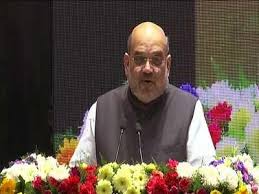In our lifetime, will see country where English speakers will be ashamed: Amit Shah

India, a nation of immense linguistic diversity, is at a critical juncture in its cultural and political narrative. Union Home Minister Amit Shah’s latest statement — “those who speak English will soon feel ashamed” — has sparked conversations across the country. Made during the launch of a book by former IAS officer Ashutosh Agnihotri, Shah’s remarks reflect a larger vision: an India that prioritizes its own languages over colonial influences.
At first glance, this might appear provocative. But beneath the surface, Shah’s assertion is not merely about English as a language—it’s a declaration about self-reliance, cultural pride, and decolonization of the Indian mindset.
The Vision Behind the Statement
Shah’s statement is part of the government’s broader cultural campaign aligned with Prime Minister Narendra Modi’s “Panch Pran” (Five Pledges), one of which is to “remove every trace of colonial mentality.” Language, in this context, is a potent symbol. For centuries, English has represented prestige, education, and opportunity in India. But in doing so, it has also overshadowed native languages, leaving them to fight for relevance in administrative, academic, and professional spaces.
By saying that English speakers may soon feel “ashamed,” Shah is challenging the deep-seated notion that fluency in English is a mark of superiority. Instead, he envisions an India where pride in regional and national languages is normalized—and even expected.
India’s Language Divide: A Historical Context
India’s linguistic diversity is one of its greatest cultural treasures. With 22 official languages and over 1,600 dialects, it stands as a living museum of human communication. However, during British colonial rule, English became the language of administration, law, and education—a legacy that continued even after independence.
Post-1947, despite many efforts to promote Hindi and regional languages, English maintained its dominance, especially in elite circles. It became the language of aspiration, associated with jobs, upward mobility, and global exposure. For many urban Indians, English is not just a tool—it’s an identity marker.
This divide has long created an invisible wall between the “English India” and the “Bharat” that speaks in native tongues. Amit Shah’s comments attempt to dismantle that wall.
Practical Changes Already Underway
Shah’s comments were not made in isolation. The Ministry of Home Affairs recently launched an Indian language section within the Department of Official Language to promote Hindi and other Indian languages in administration. More official communication is being conducted in native languages. There is an active push to introduce Indian languages in legal proceedings, education, and governance.
Furthermore, government-sponsored exams like the UPSC, SSC, and others are increasingly accommodating regional languages to ensure inclusivity and level the playing field.
The goal is not to ban English, but to elevate the status of Indian languages to equal, if not greater, importance.
What This Means for English Speakers
So, will English speakers really feel “ashamed” in the future?
That depends on how one interprets the statement. Shah is not suggesting that English should be vilified. Rather, he is challenging the disproportionate reverence it receives. In a truly self-confident India, fluency in Hindi, Tamil, Bengali, Marathi, or any other Indian language should be as respected—if not more—than English.
English will likely continue to have a role in diplomacy, business, and global engagement. But within India, the expectation is shifting. Language should no longer be a status symbol or a barrier. Respect for Indian languages is no longer optional—it’s integral to India’s evolving national identity.
The Southern Perspective: A Complicated Relationship with Hindi
While Shah’s push for linguistic pride is rooted in nationalism, it has also met resistance—particularly from southern states like Tamil Nadu and Kerala. These regions have long opposed the imposition of Hindi and are wary of any move that appears to undermine linguistic federalism.
For them, English serves as a neutral medium—a bridge that allows communication across diverse linguistic groups without prioritizing any single Indian language. Replacing English with Hindi, even under the banner of decolonization, risks reopening old wounds.
Thus, the challenge for the government is to promote all Indian languages equally, not just Hindi, and ensure that efforts to diminish colonial legacies do not inadvertently stoke regional tensions.
Language as a Marker of National Confidence
Ultimately, Shah’s statement is a call for cultural confidence. Language is not merely a means of communication; it is a vessel of heritage, identity, and worldview. When a nation begins to take pride in its own languages, it signifies deeper self-assurance.
This vision aligns with a broader cultural renaissance across India—from embracing traditional knowledge systems to promoting Indian attire, architecture, and education models rooted in Indian ethos.
Conclusion: Toward a Multilingual Future
Amit Shah’s remarks may seem bold, but they strike at the heart of an important national conversation. As India continues to rise on the global stage, the country must decide what kind of cultural foundation it wishes to stand on.
Rather than feeling “ashamed” of English, perhaps the real message is this: be proud of your mother tongue first. English can remain a useful tool—but it should not be the only standard for intelligence, sophistication, or success.
India’s future lies in multilingualism—not just in using many languages, but in honoring them equally. That’s the India Shah envisions—and perhaps one we’re already beginning to see.






